Rangoli is an ancient Indian art form that has captivated people for centuries. Rooted in tradition and culture, it is a beautiful way to express creativity and bring color to our lives. Rangoli designs are intricate patterns and vibrant colors created on the floor, usually in front of homes and temples, using colored powders, rice, flower petals, and other natural materials.
This article delves into the captivating world of rangoli, exploring its history, significance, and a collection of stunning rangoli designs to inspire your artistic journey.
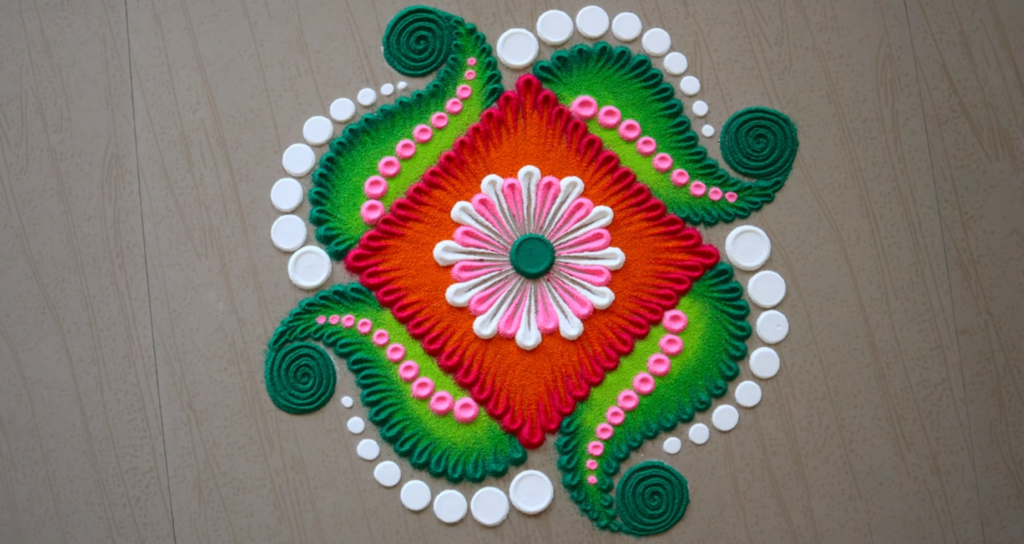
Table of Contents
The Origin and Significance of Rangoli
The word “rangoli” is derived from the Sanskrit word “rangavalli,” which means a row of colors. The art form has deep roots in Indian culture and has been an integral part of various festivals and celebrations for generations. Rangoli is not just a decorative art but also carries spiritual and social significance.
In ancient times, women used to create rangoli designs at the entrance of their homes as a symbol of welcoming guests and the gods.
It was believed that the intricate patterns and bright colors would invite prosperity, happiness, and positive energy into the household. Rangoli was also considered an offering to the deities, as it was made using natural materials found in the environment.
Artistic Process of Creating Rangoli Designs
Creating a rangoli design is a meticulous and artistic process that requires patience, precision, and creativity. Here is a step-by-step guide to making a traditional rangoli:
- Selecting the Design: The first step in creating a rangoli is selecting the design. Rangoli designs can vary widely, from simple geometric shapes to intricate nature-inspired patterns. The choice of design depends on the occasion, the size of the space, and the artist’s creative preferences. Some artists opt for traditional designs with religious symbols, while others experiment with contemporary and abstract patterns.
- Cleaning the Area: Before creating a rangoli, it is essential to clean the area thoroughly. Rangoli is typically made on the floor, and a clean surface ensures that the colors adhere well and the design looks neat. Sweeping away any dust or debris also creates a sense of freshness and purity, in line with the spiritual significance of rangoli.
- Outlining the Design: Outlining the design is a crucial step in the rangoli-making process. Using chalk or a white powder, the basic structure of the design is marked on the floor. This step helps the artist maintain symmetry and balance while filling in the colors. The outlines serve as guidelines for creating intricate patterns and details.
- Filling in the Colors: This is the most creative and exciting part of making a rangoli. Vibrant colors are used to fill in the rangoli design, creating a visual masterpiece. Traditional rangoli colors include red, yellow, green, blue, and white, each holding its unique significance. Colored powders, rice flour, or flower petals are commonly used to add hues and textures to the rangoli.
- Adding Details: Adding intricate details is what gives rangoli designs its character and beauty. Small dots, lines, curves, and shapes are used to enhance the design and make it more visually appealing. The artist’s skill and creativity come into play here, as they add their personal touch to the artwork.
- Enhancing with Diyas and Lamps: Placing diyas (oil lamps) or tealights around the rangoli designs is a delightful way to elevate its beauty. Lighting the diyas during the evening creates a warm and inviting atmosphere, adding a touch of charm and spirituality to the artwork. The flickering flames of the lamps dance with the colors of the rangoli, creating a mesmerizing display.
Now, let’s explore a collection of mesmerizing rangoli designs that showcase the versatility and beauty of this art form.
Rangoli Designs
- Floral Extravaganza:
A flower does not use words to announce its arrival to the world; it just blooms.
Matshona Dhliwayo.
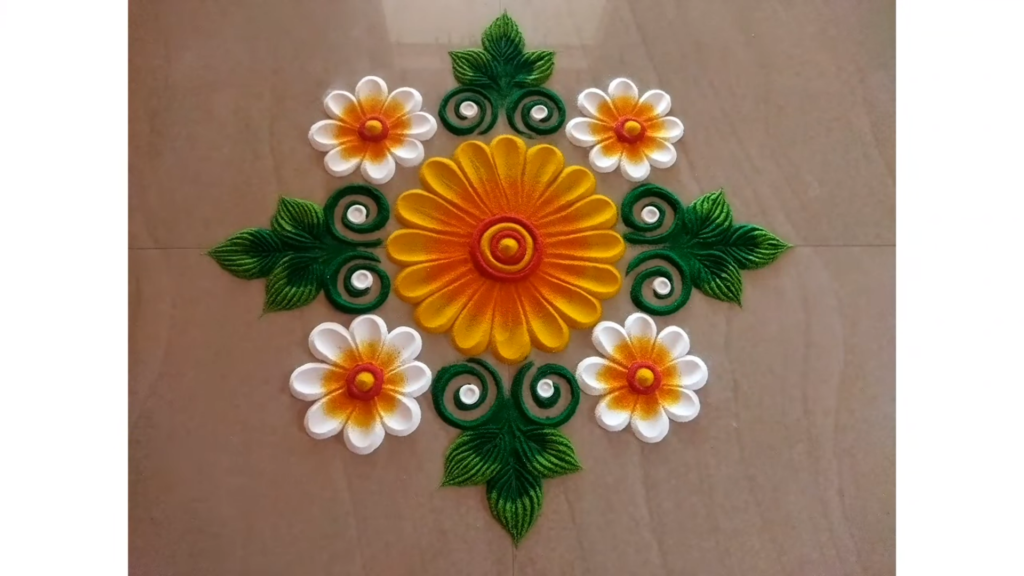
“Floral Extravaganza” is a stunning and visually opulent rangoli design that celebrates the beauty and abundance of nature’s floral treasures. This captivating artwork showcases a profusion of intricate and lifelike floral motifs, meticulously crafted to evoke a sense of awe and wonder. The rangoli design blooms with a rich tapestry of colors, as vibrant flower petals and lush green leaves come together in a symphony of nature’s colors and grace.
At the heart of the design lies the artist’s skillful use of floral patterns and detailing. Each flower is delicately crafted, capturing the essence of its unique form and character. The use of contrasting colors and shading techniques adds depth and dimension to the design, creating a visual feast that mirrors the lushness of a blossoming garden. The rangoli becomes a vibrant canvas of nature’s beauty, where the fragrant blooms seem to come alive, infusing the space with the freshness and vitality of a spring morning.
The video included below will show you how to make the above design. Please checkout Rangoli Art by Kalai for more such videos.
- Peacock Delight:
“Be like a peacock and dance with all of your beauty.”
Debasish Mridha
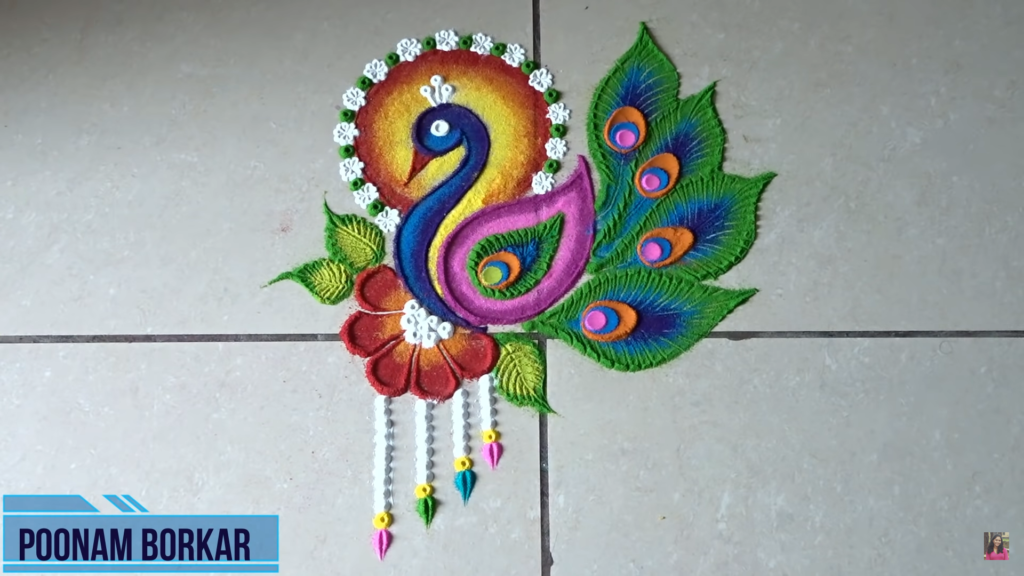
It is an exquisite and enchanting rangoli design that pays tribute to the majestic beauty of the peacock. This captivating artwork captures the grace and elegance of the peacock, showcasing its vibrant plumage in a burst of colors. At the heart of “Peacock Delight” lies a stunning depiction of the peacock, with its feathers intricately crafted to evoke a sense of realism and wonder.
The artist skillfully blends shades of blue, green, and gold, creating a mesmerizing display that mirrors the iridescent allure of the peacock’s feathers.
Beyond its visual appeal, “Peacock Delight” holds cultural and symbolic significance. In Indian mythology and art, the peacock is associated with beauty, grace, and spiritual symbolism. The rangoli design serves as a representation of nature’s splendor and a reminder of the interconnectedness between human beings and the natural world. As the “Peacock Delight” rangoli adorns homes and public spaces, it symbolizes a harmonious coexistence with nature, and the appreciation for the magnificence of creation.
The video included below will show you how to make the above design. Please checkout Poonam Patil for more such videos.
- Diwali Sparkle:
“It was pitch dark, some lamps were burning
a Punjabi Proverb
the world seeks those who seek such yearning”
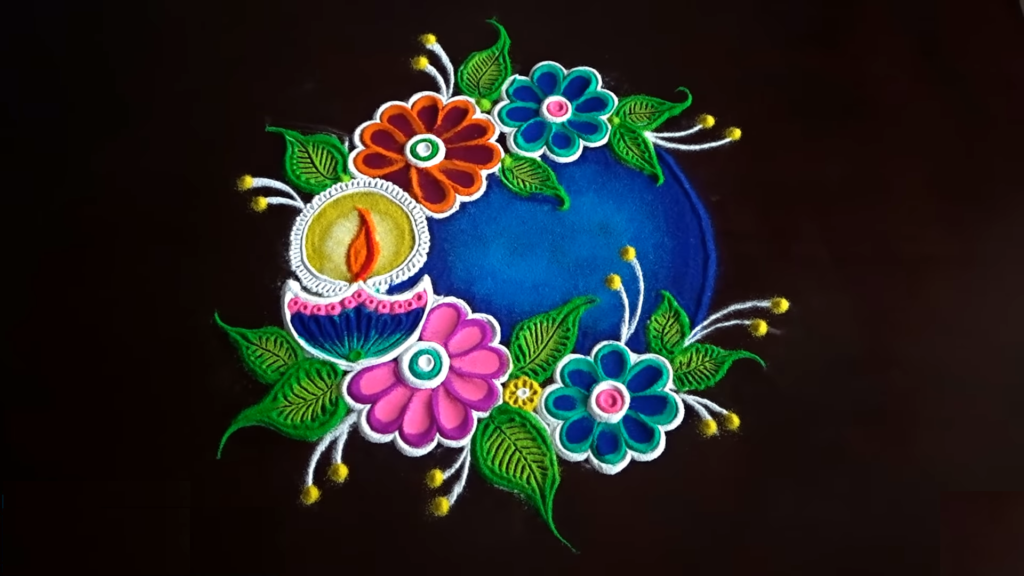
“Diwali Sparkle” is a dazzling and enchanting rangoli design that encapsulates the vibrant and joyous spirit of the Festival of Lights. This mesmerizing artwork celebrates the essence of Diwali, where homes and streets are adorned with a brilliant display of lights and decorations. At the heart of “Diwali Sparkle” lies a symphony of vibrant colors, shimmering glitters, and radiant diyas (oil lamps) that come together to create a visual spectacle that illuminates the darkness and ignites the festive ambiance.
The artist skillfully weaves intricate patterns and designs, reflecting the celebratory mood of Diwali. The use of bright and bold colors like red, orange, yellow, and green adds to the visual appeal and evokes a sense of energy and excitement. The incorporation of sparkling glitters enhances the rangoli’s allure, replicating the twinkling of Diwali lights and creating a sense of magic and enchantment. The rangoli is often adorned with lit diyas, symbolizing the victory of light over darkness and spreading a warm and welcoming glow that signifies the triumph of good over evil.
Creating “Diwali Sparkle” requires a delicate touch and a keen eye for detail. The artist must skillfully apply the glitters and colors, ensuring a balanced and harmonious composition that captivates the eyes of onlookers. The rangoli serves as a focal point of celebration during Diwali, drawing people together to marvel at its beauty and bask in the radiant ambiance of the festival. To know more about Diwali click here and what to do on the day click here As families and communities gather around “Diwali Sparkle,” they are filled with joy and a sense of togetherness, rejoicing in the festive spirit and the bright hope that the lights of Diwali bring for the year ahead.
The video included below will show you how to make the above design. Please checkout Poonam Patil for more such videos.
- Swirling Symmetry:
Beauty is rather a light that plays over the symmetry of things than that symmetry itself
Plotinus
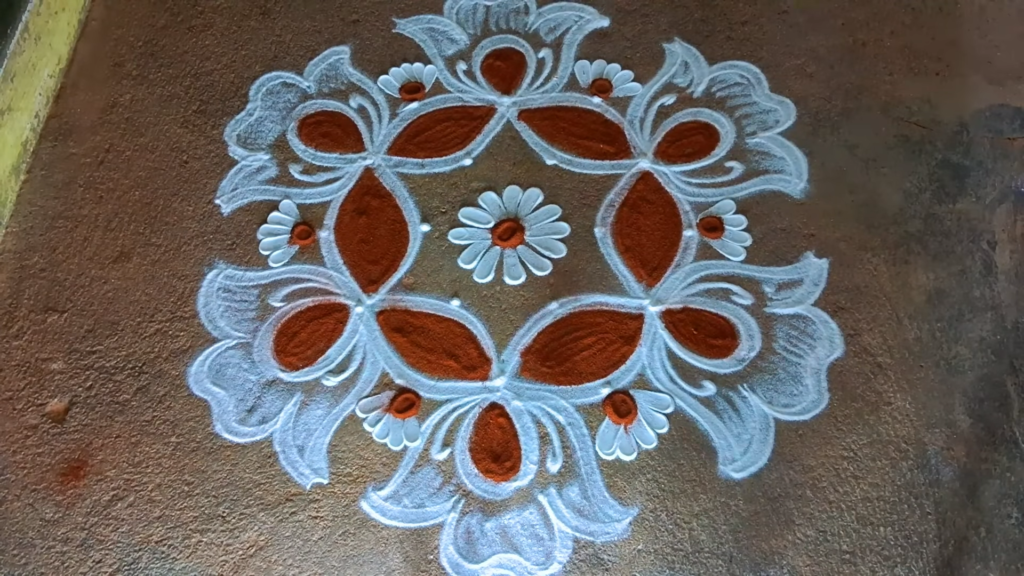
“Swirling Symmetry” is a mesmerizing and visually captivating rangoli design that celebrates the harmony and balance of symmetrical patterns. This exquisite artwork weaves together swirling lines and intricate shapes, creating a sense of movement and fluidity that draws the viewer’s gaze into a captivating dance of symmetry. The symmetrical composition of “Swirling Symmetry” creates a mesmerizing visual effect, where each swirl and curve is mirrored and balanced, evoking a sense of tranquility and order.
At the heart of “Swirling Symmetry” lies the artist’s skillful use of fluid lines and intricate detailing. The symmetrical patterns flow effortlessly across the canvas, creating a hypnotic and dynamic visual experience. The rangoli design is often adorned with a harmonious color palette, adding depth and dimension to the swirling patterns. As the eyes follow the intricate lines, a sense of calmness and harmony washes over the observer, immersing them in the mesmerizing beauty of swirling symmetry.
Creating “Swirling Symmetry” requires precision and an eye for detail. The artist must meticulously plan the arrangement of swirling lines, ensuring their balance and mirrored forms. The use of colored powders or flower petals allows for a creative expression of artistic vision, adding a touch of vibrancy and life to the design.
As people gather around “Swirling Symmetry,” they are entranced by its captivating allure. The rangoli serves as a focal point of fascination and contemplation, offering a moment of serenity and appreciation for the artistry and captivating beauty of swirling symmetry.
The video included below will show you how to make the above design. Please checkout Kaalai Thendral kolangal for more such videos.
- Lotus Blooms:
“A lotus only blooms in mud”
A Hindi proverb

“Lotus Blooms” is an exquisite and sacred rangoli design that pays homage to the revered lotus flower. This enchanting artwork captures the ethereal beauty and spiritual significance of the lotus, a symbol of purity, enlightenment, and divine grace. At the center of “Lotus Blooms” lies a stunning depiction of the lotus in full bloom, crafted with delicate and intricate petals that mirror the softness and elegance of the real flower. The artist skillfully blends vibrant hues of pink, white, and green, creating a mesmerizing kaleidoscope of colors that evoke a sense of serenity and tranquility.
Beyond its visual allure, “Lotus Blooms” holds profound spiritual symbolism. In Hindu mythology, the lotus is associated with deities like Goddess Lakshmi and Lord Vishnu, representing divinity and spiritual enlightenment. As the rangoli adorns homes and courtyards during festivals, it sets the stage for auspicious celebrations and invites blessings and positive energy into the space.
The “Lotus Blooms” rangoli serves as a reminder of the beauty and grace that emerge even in murky waters, symbolizing the journey from darkness to light, ignorance to wisdom, and adversity to triumph.Creating “Lotus Blooms” demands artistic finesse and a deep appreciation for the lotus’s spiritual significance. The artist must meticulously craft each petal with precision and attention to detail, ensuring that the design exudes the lotus’s timeless beauty and sacred aura.
As people gather around “Lotus Blooms,” they are drawn into its enchanting beauty and spiritual aura. The rangoli creates a sense of serenity and calmness, offering a moment of reflection and appreciation for the divinely inspired artistry and the eternal symbolism of the lotus flower.
The video included below will show you how to make the above design. Please checkout Pakka Local here for more such videos.
- Geometric Elegance:
“Geometry is the archetype of the beauty of the world.”
Johannes Kepler
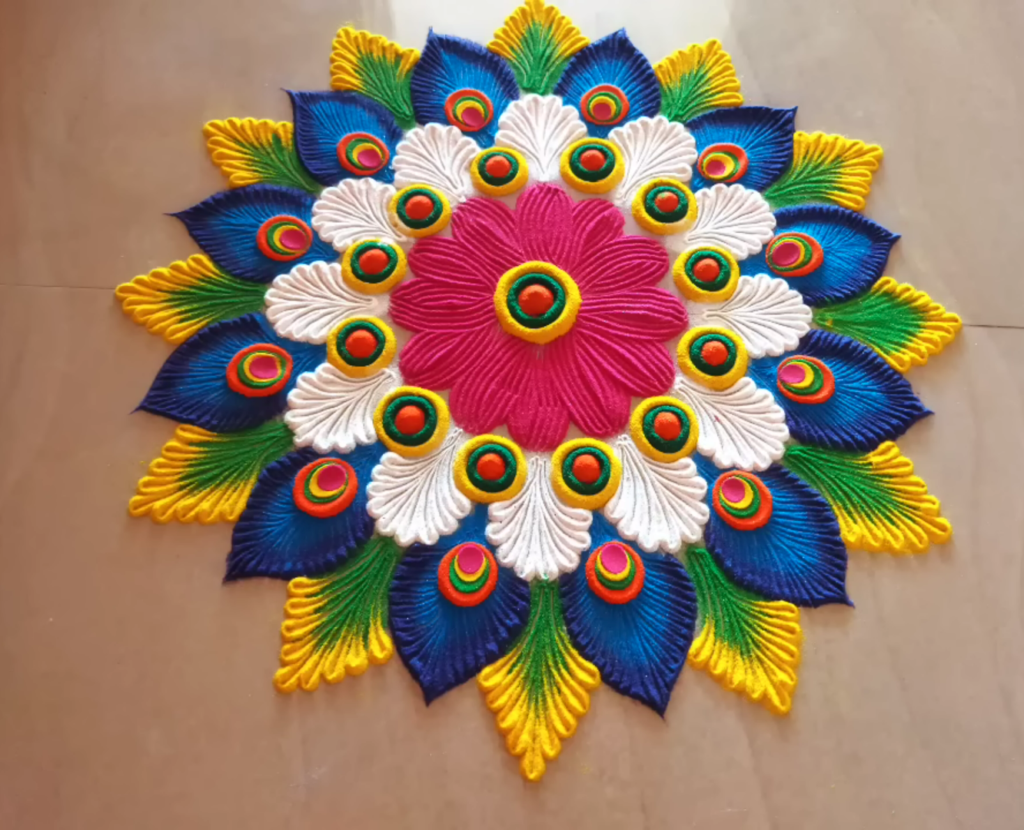
“Geometric Elegance” is a captivating rangoli design that celebrates the beauty of simple shapes and symmetrical patterns. This artistic masterpiece showcases the versatility of rangoli art, where the interplay of geometric figures and intricate detailing creates a mesmerizing visual spectacle.
The heart of “Geometric Elegance” lies in its precision and balance. The artist skillfully employs various geometric elements, such as circles, squares, triangles, and lines, to compose a harmonious and visually stunning design. Each shape is meticulously crafted, ensuring precise proportions and symmetry throughout the artwork.
The use of vibrant colors adds a touch of liveliness and enhances the beauty of the geometric patterns. “Geometric Elegance” embodies a sense of order and harmony, offering viewers a moment of serenity and appreciation for the beauty found in simplicity and mathematical precision.
Creating “Geometric Elegance” demands a keen eye for detail and a steady hand. The artist must carefully plan the arrangement of geometric shapes, ensuring their symmetry and balance. The use of rangoli powders or colored chalk allows the artist to bring the design to life with a myriad of hues, creating a mesmerizing visual display.
As people gather around “Geometric Elegance,” they are drawn into its hypnotic allure. The symmetrical patterns and intricate detailing create a sense of tranquility and calmness, offering a moment of respite from the hustle and bustle of daily life. This rangoli design not only adorns homes during festivals but also serves as a reminder of the timeless beauty of geometry and its ability to create a sense of harmony and balance in the world around us.
The video included below will show you how to make the above design. Please checkout Rangoli Art by Kalai for more such videos.
- Nature’s Whimsy:
“Nature is not a place to visit, it is home.”
Gary Snyder

“Nature’s Whimsy” is an enchanting and imaginative rangoli design that draws inspiration from the wonders of the natural world. This captivating artwork celebrates the playful and unpredictable nature of Mother Earth, where elements of flora and fauna dance together in a delightful display of whimsical charm. The rangoli design weaves together intricate floral motifs, swirling vines, and depictions of animals and birds, creating a dreamlike composition that transports viewers to a world of fantasy and magic.
At the heart of “Nature’s Whimsy” lies the artist’s creative interpretation of nature’s bounty. Delicate flowers with gracefully curving petals blend seamlessly with swirling vines, evoking a sense of movement and liveliness. Birds and butterflies delicately perched on flowers add to the artwork’s enchanting ambiance, bringing the scene to life with their playful presence. The artist’s skillful use of vibrant colors adds to the visual appeal, infusing the rangoli with the joyous spirit of nature’s whimsy.
Creating “Nature’s Whimsy” requires a bold and imaginative approach to art, where the artist blends their artistic vision with the inherent charm of nature. The use of colored powders or flower petals allows for a fluid and spontaneous expression of creativity. As people gather around the “Nature’s Whimsy” rangoli, they are transported to a world of magic and wonder, where the playful beauty of nature unfolds in all its whimsical glory, leaving observers captivated by the artistry and ingenuity of the natural world.
The video included below will show you how to make the above design. Please checkout Rangoli Art by Kalai for more such videos.
- Divine Blessings:
“The harvest of old age is the recollection and abundance of blessing previously secured.”
Marcus Tullius Cicero

“Divine Blessings” is a profoundly spiritual and sacred rangoli design that embraces the essence of devotion and gratitude towards the divine. This enchanting artwork serves as a visual representation of seeking the blessings and benevolence of revered deities. Each element in the rangoli is meticulously chosen to symbolize the presence of divine grace and protection.
At the heart of “Divine Blessings” lies a fusion of sacred symbols, auspicious signs, and depictions of revered deities like Lord Ganesha, Goddess Lakshmi, Lord Krishna, and more. Each representation carries deep spiritual significance, bestowing the rangoli with a sense of sacredness and divine energy. As the intricate patterns and symbols interweave, the “Divine Blessings” rangoli designs becomes a conduit for invoking the blessings and positive energy from the divine realm.
The creation of “Divine Blessings” requires not only artistic finesse but also a deep understanding of the spiritual significance of each symbol and deity. The rangoli artist infuses devotion and reverence into every stroke, transforming the canvas into a manifestation of heartfelt prayers and devotion. As people gather around the “Divine Blessings” rangoli, they are filled with a sense of awe and reverence, inviting them to seek divine blessings, protection, and guidance in their lives.
The video included below will show you how to make the above design. Please checkout Rangoli Art by Kalai for more such videos.
- Abstract Delights:
“There is no abstract art. You must always start with something. Afterward you can remove all traces of reality.”
Pablo Picasso
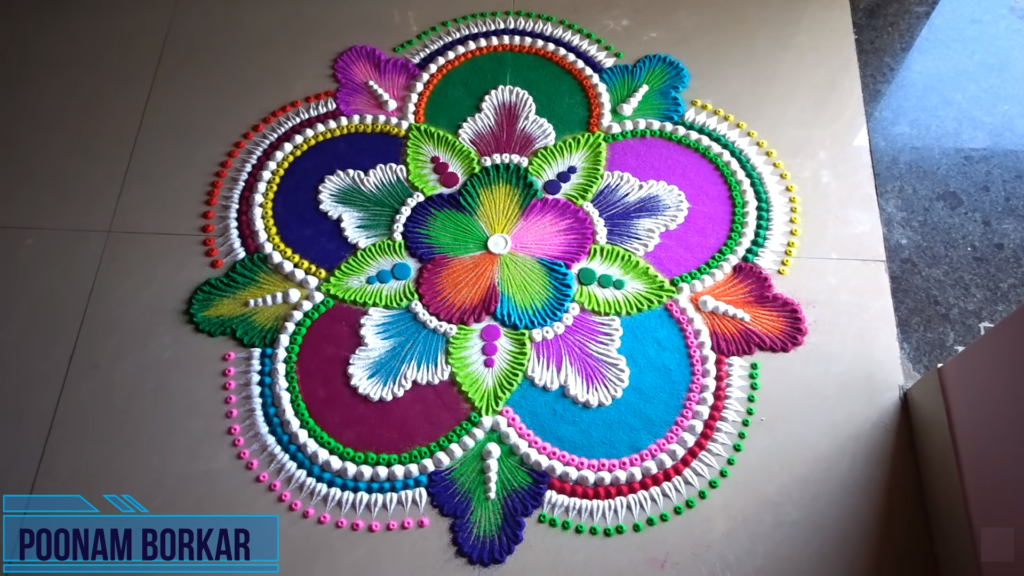
“Abstract Delights” is a mesmerizing and enchanting rangoli design that transcends conventional art forms, embracing the boundless realm of abstraction. This captivating artwork weaves together a symphony of geometric shapes, fluid lines, and vibrant colors, creating a visual masterpiece that sparks curiosity and ignites the imagination. The absence of representational forms allows each viewer to interpret the design in a unique and personal way, fostering a sense of connection with the artwork.
At the core of “Abstract Delights” lies the freedom of artistic expression and the celebration of creativity. The artist’s skillful use of geometric patterns and swirling lines creates a dynamic composition that seems to come alive, inviting the viewer on a journey of exploration. The rich and diverse color palette adds depth and emotion to the artwork, evoking a range of feelings and experiences. “Abstract Delights” is a celebration of the inherent beauty in simplicity and the magic that arises when art transcends the boundaries of conventionality, leaving us in awe of the vast possibilities of artistic expression.
The video included below will show you how to make the above design. Please checkout Poonam Patil here for more such videos.
- Traditional Grandeur:
“It takes an endless amount of history to make even a little tradition.”
Henry James

“Traditional Grandeur” is a resplendent and majestic rangoli design that stands as a magnificent ode to the time-honored traditions and cultural heritage of India. This extraordinary artwork showcases the exquisite craftsmanship and artistic prowess of rangoli artists, blending intricate patterns, vivid colors, and sacred symbols in a harmonious display of opulence.
At the heart of “Traditional Grandeur” lies a carefully curated collection of traditional motifs and patterns, passed down through generations. Each delicate line and curve is meticulously crafted, a testament to the artist’s dedication and skill in preserving the essence of age-old artistry. Rich and vibrant hues create a captivating symphony of colors that exude the jubilant spirit of Indian festivities.
Sacred symbols, such as the auspicious “Om” and the revered “Swastika,” intricately weave into the rangoli’s design, infusing the artwork with divine blessings and positive energy. The symmetrical composition radiates a sense of balance and harmony, capturing the timeless grace and allure of traditional rangoli. As the design adorns homes and public spaces during celebrations, it becomes a captivating centerpiece that evokes admiration and awe.
“Traditional Grandeur” is not merely an artwork; it is a visual representation of India’s cultural legacy and the enduring connection between art and spirituality. As people gather around this masterpiece, they are transported to a world of grandeur and splendor, where the rich tapestry of tradition and creativity intertwines to create an unforgettable spectacle. Through “Traditional Grandeur,” rangoli designs art stands tall as a beacon of India’s cultural heritage, inspiring generations to cherish and perpetuate the beauty of this ancient art form.
The video included below will show you how to make the above design. Please checkout Rangoli Art by Kalai for more such videos.
Rangoli is a timeless art form that beautifully showcases the rich cultural heritage of India. The intricate rangoli designs and vibrant colors bring joy and positivity to our lives, making festivals and celebrations even more special. Creating a rangoli is an opportunity to express creativity and celebrate the beauty of life.
Whether it’s Diwali, Navratri, or any other auspicious occasion, rangoli designs continue to be a cherished tradition that connects us with our roots and brings us closer to the beauty of art and nature. So, the next time you celebrate a special moment, let rangoli designs add its magical touch and fill your life with colors and happiness.
